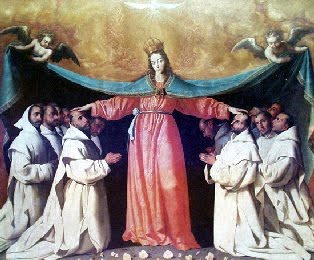 Since the inception of SECRET HARBOR, Julia Crotta, a.k.a. Sister Nazarena has been the subject of a couple of posts, here and here. Paul Augustin Mayer, O.S.B. was also the subject of a previous post. There was some correspondence between these two holy individuals.
Since the inception of SECRET HARBOR, Julia Crotta, a.k.a. Sister Nazarena has been the subject of a couple of posts, here and here. Paul Augustin Mayer, O.S.B. was also the subject of a previous post. There was some correspondence between these two holy individuals.Sister Nazarena lived as an anchoress for forty-five years in a monastery of Camaldolese Benedictine nuns in Rome. She received her call to the desert while she was a college student in Connecticut. It was in March of 1934 during a Holy Week retreat that Julia Crotta heard a voice calling her name, while alone in a convent chapel. She had a vision of a man weeping and stretching out his wounded hands. The wounded man called her to the desert and promised her his abiding presence. This is how it all began for Julia.
Her final destination was with the Camaldolese nuns of Sant’Antonio where she would be an anchoress. Her cell was isolated from the rest of the community where she lived a life of prayer, penance, solitude and silence. She wanted to be as she wrote, “the most hidden and least-known soul in the world – truly and totally hidden with Christ in God.”
Father Augustin Mayer met Sister Nazarena shortly after she arrived at the monastery. Father Mayer was a Benedictine theologian who was impressed with Sister Nazarena. Father Mayer, who would eventually become an abbot and a cardinal, had questions which dealt with fostering a spirit of contemplation in his world of academics. Sister Nazarena filled many pages with advice for fostering a contemplative journey.
In her first letter to Father Mayer, Sister Nazarena addressed him as “my dear brother priest” which reflected what she shared with him by explaining that she had a “priestly soul” because she felt that in her vocation she was offering the Blood of Christ with ordained priests. Humbly, in that first letter to Father Mayer, she wrote that she was embarrassed by the thought of her spiritual counseling. In that letter, though, she wrote: “I sense that within yourself you are groping about, that never, since your birth, have you enjoyed the peace and tranquility of those who are sure they are on the path that suits them.” She advised him to trust in the Holy Spirit and the Blessed Virgin Mary since the Incarnate Word of God was formed by the Holy Spirit in Mary’s womb. She continued: “The Lord wants to be able to count on you; He wants you to have such abundant reserves of the divine life, that it will flow upon… those whom He most loves and renders fit for the building up of Christ’s Mystical Body – the priestly souls. I also greatly desire, by God’s grace, to become like my dear priests, ‘another Christ,’ after my own fashion. May I, like Him, in Him, with Him, give my blood drop by drop, but in total hiddenness rather than on the battlefield. Until the end of ages, may I never cease to work for ‘all souls’ according to this ideal.”
This was a bit of a mysterious statement and Sister Nazarena knew it. Thus she continued: “Let me share with you my ideal… May you offer, together with the sacramental Host, this pristine, hidden host of love for Jesus; humbly ask Him to accept and totally transform her, so that she may be made ‘wholly divine,’ and thus it will be He, not she, Who lives and works again on Earth. I have no better way of helping ‘my dear brother priests’ than by becoming like them, a priestess, working and giving my life for the same ideals.”
This was not an agenda to ordain women as priests, but as the author of Nazarena: An American Anchoress explains: The use of grammatical gender in Italian renders the identification of the “hidden host of love” with Nazarena herself quite obvious; in other words, through the ministry of the priest, her offering as an anchoress is taken up totally into the sacramental Victim.
Father Mayer was the only person to ever have received correspondence from Sister Nazarena which expressed her thoughts of being a “hidden host of love.”











